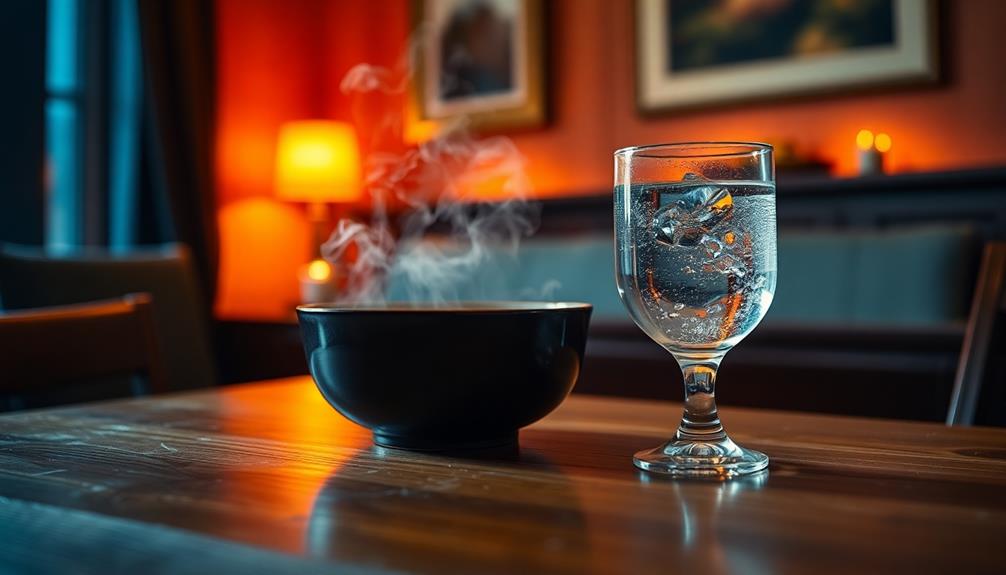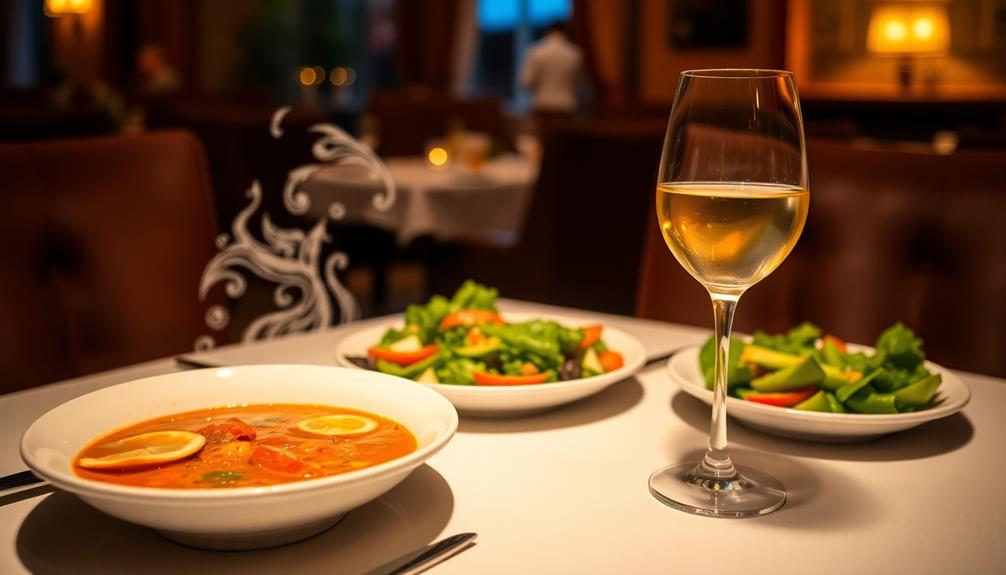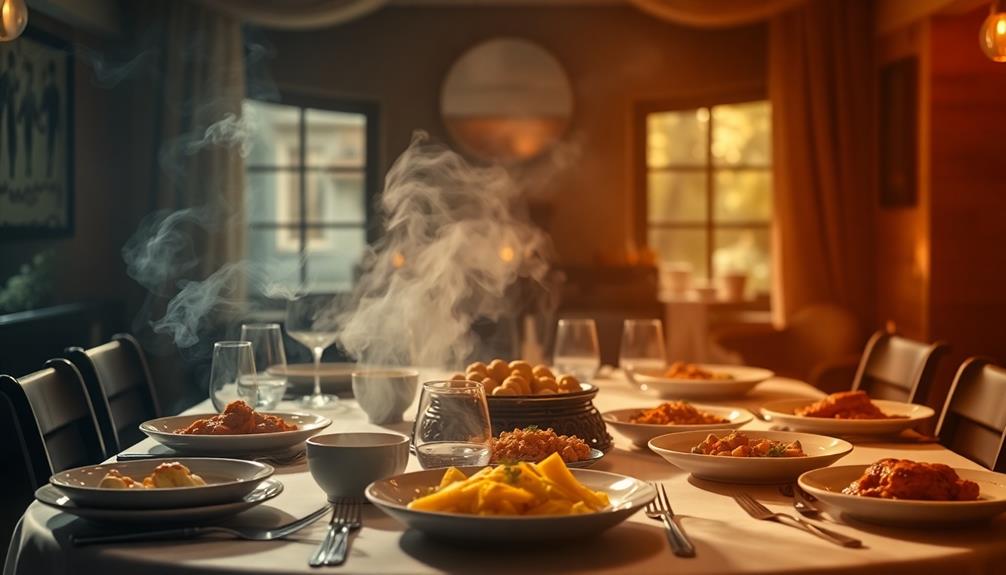Room temperature is crucial in how we perceive flavors. When food is served between 15-35°C, we can fully experience the sweet, bitter, and umami tastes. Higher temperatures can enhance sweetness and aroma, making every bite more enjoyable. Conversely, cooler temperatures can dull flavors and decrease sensitivity to sweetness. For instance, fruit salads may taste better when served at room temperature. By adjusting the ambient temperature, we can enhance our dining experience and reveal hidden flavors in our preferred dishes. There is still much to discover about the impact of temperature on our taste buds.
Key Takeaways
- Room temperature enhances sweetness and umami, making foods more flavorful compared to colder temperatures, which can mute these tastes.
- Ideal taste perception occurs between 15-35°C, where flavors, especially sweet and bitter, are most intense.
- Aroma perception diminishes at room temperature, impacting overall flavor enjoyment, particularly in hot beverages.
- Heating foods can increase sweetness but may unexpectedly intensify bitterness, altering taste experiences.
- Expectations about food temperature significantly influence taste perception, affecting individual flavor preferences and enjoyment.
Understanding Taste Perception

When it comes to understanding taste perception, temperature plays a crucial role in how we experience flavors. Your taste perception is most sensitive to sweet, bitter, and umami tastes when food is at a lukewarm temperature, ideally between 15-35°C. This is why dishes like Red-Braised Pork Belly, which rely on rich flavors, are best enjoyed when served warm. At this ideal sensitivity range, flavors come alive, making each bite more enjoyable.
Interestingly, temperature can also alter how you perceive different tastes. For instance, as food heats up, you might find its sweet taste intensifies, while bitter notes can become masked. This dynamic interplay means that the same dish can taste markedly different depending on its temperature.
When you eat cold foods, like strawberries or tomatoes, they may feel less sweet and flavorful compared to when they're at room temperature.
Moreover, as you age, your thermal sensitivity may change, influencing your flavor experiences. Starting around age 40, you might find that temperature's effect on taste perception becomes even more pronounced, underscoring the significance of enjoying foods at the right temperature for ideal flavor.
The Role of Temperature

When you taste food, the temperature plays an essential role in how you experience flavors. Warmer foods can make sweetness pop, while cooler options might mute that same flavor.
For example, serving a Grilled Peach and Burrata Salad at room temperature can enhance the sweetness of the peaches and the creaminess of the burrata.
Understanding how temperature affects taste can help you enhance your culinary experiences.
Temperature's Impact on Taste
Temperature plays an essential role in how you perceive taste, with ideal sensitivity for sweet, bitter, and umami flavors occurring between 15-35°C. This range is vital, as it enhances the perceived intensity of these taste sensations.
For example, enjoying a delicious Turkey Sandwich (For Leftovers) at room temperature allows you to appreciate the flavors of the turkey and toppings more fully. When foods are served at the right temperature, you can truly appreciate their flavors.
- Cold temperatures can dampen sweetness and umami.
- Warmth boosts the thermal sensitivity of sweet flavors due to heat activation in taste receptors.
- Bitter tastes seem less intense when food is hot.
Serving temperature greatly affects flavor perception, too. For instance, room temperature tomatoes and strawberries deliver intense sweetness compared to their hot or cold versions, which can mask true flavors.
Curiously, warmth can make sourness more pronounced while lessening the impact of bitter tastes.
As you age, changes in taste sensitivity can occur, starting around age 40. This makes managing temperature even more important for enhancing flavor experiences, particularly for older adults.
Sweetness and Bitterness Changes
The interplay between sweetness and bitterness is considerably influenced by the temperature at which food is served. When you enjoy sweet foods like sucrose or fructose, their flavors peak around 35°C, enhancing your taste perception.
Similarly, traditional Brazilian desserts such as Brigadeiro reach their fullest flavor potential when served warm, as the warmth helps to accentuate their sweetness. If you serve these treats too cold, their sweetness can diminish considerably, leading to a less enjoyable experience. Your taste buds lose sensitivity to sweet flavors in cooler conditions, and you may find the dish less appealing.
On the other hand, bitterness becomes more pronounced at room temperature. For instance, the bitter notes in caffeine are heightened in warmer settings. This means that lukewarm beverages may intensify the bitterness, altering your overall perception of flavor.
Research shows that the ideal range for taste perception falls between 15-35°C, where the balance of sweetness and bitterness is just right.
Neural Responses to Heat
Understanding how temperature affects taste perception reveals fascinating insights into our sensory experiences. Temperature plays an essential role in how our taste receptors respond to different flavors. For instance, the ideal temperatures between 20°C and 35°C (68°F to 95°F) help enhance the flavors of traditional dishes like pasta with tomato sauce, where the warmth can elevate the sweetness of tomatoes and the richness of the sauce. At these temperatures, the neural firing intensity of taste receptors peaks, particularly for sweetness and umami.
- Cooling enhances neural firing for low concentrations of sodium chloride, making salty flavors more pronounced.
- Warm temperatures boost sweet taste perception, thanks to the activity of TRPM5 channels in taste receptor cells.
- Extreme temperatures can dampen the intensity of sweetness and umami, altering your overall taste experience.
The mammalian gustatory system effectively integrates temperature and taste signals through cranial nerve fibers, particularly the chorda tympani and glossopharyngeal nerves. This bimodal sensitivity means that both cooling and warming can greatly affect taste perception. This interaction between temperature and taste can have implications for food preferences and consumption behavior, especially in varying environmental conditions. For instance, beverages served at colder temperatures might enhance or suppress particular flavors, thus influencing both the hydration and tasting experience. Understanding how temperature modulates taste perception can provide valuable insights for optimizing the flavor profiles of foods and drinks to elevate consumer satisfaction.
Sensory Interactions in Flavor

When you enjoy your food, temperature plays an essential role in how you perceive taste. Warmer dishes often release more aroma, enhancing flavor, while cooler items can dull sweetness and heighten bitterness.
For instance, traditional Indonesian desserts like Kue Putu are best enjoyed warm, which greatly enhances their rich coconut and palm sugar flavors.
Temperature's Impact on Taste
Temperature plays an essential role in how you perceive taste, influencing the intensity of flavors in surprising ways. Your taste receptors are most sensitive between 20°C and 35°C (68°F to 95°F), where you experience peak sweetness, bitterness, and umami. When you serve food at these ideal temperatures, you can greatly enhance your taste experience.
For instance, certain dishes like Dorayaki (Red Bean Pancake) can taste more delightful when served at room temperature, allowing the sweetness of the red bean paste to shine through.
- Cold temperatures reduce sweetness and umami, dulling those delightful flavors.
- Heating food can intensify bitterness, making it more pronounced than you might expect.
- Room temperature serving enhances the flavor profile of fruits like tomatoes and strawberries, bringing out their natural sweetness.
Your taste perception hinges on thermal conditions, with the TRPM5 receptor playing a vital role in how you detect these flavors. As you age, you may lose some taste buds, which can further alter your flavor experience.
Aroma and Flavor Connection
The interplay between aroma and taste is a vital factor in how you experience flavor. When you sip hot coffee, the elevated temperature helps release more aromatic compounds, enhancing your flavor perception. This results in a more enjoyable taste experience, as the delightful aroma can even mask undesirable flavors, like bitterness.
Notably, this concept can also be applied to various Indian dishes, such as Mushroom Masala, where the rich blend of spices enhances the overall flavor profile. As the temperature of your coffee decreases, however, the aroma diminishes, leading to a less satisfying taste and a preference for hotter beverages.
Research shows that the interaction between taste and olfactory components, or sensory modalities, is essential for crafting a complete flavor profile. Ideal temperature plays a significant role in this, as hotter drinks tend to provide a richer aroma, which in turn influences consumer preferences and overall satisfaction levels.
If you've ever wondered why you might enjoy that steaming cup of coffee more than one left at room temperature, it's all about how those aromas interact with your taste buds. Understanding this connection can help you make more informed choices when it comes to your favorite beverages, ensuring you always enjoy the best flavor experience.
Psychological and Physiological Effects

Understanding the psychological and physiological effects of room temperature on taste perception can really enhance your eating experience. Room temperature plays an essential role in how you perceive flavors, with ideal conditions for sweetness, bitterness, and umami lying between 15-35°C. When food is outside this range, you might notice a muted flavor experience. For instance, serving a classic Southern dish like squash casserole at the right temperature can elevate its comforting flavors.
Here are some key influences to reflect on:
- Psychological factors: Your expectations about food temperature can greatly alter your taste perception. If you expect something to be sweet, a warmer temperature might enhance that sensation.
- Physiological interplay: Cooling foods can decrease the perception of bitterness, while warming them can boost sweetness, affecting how your taste receptors respond.
- Individual differences: You may have unique sensitivities to certain tastes at room temperature, leading to varied flavor preferences.
Additionally, room temperature diminishes aroma perception, which is essential for flavor. Hot foods release more volatile compounds, enhancing your overall taste experience.
Practical Applications for Eating

Enjoying your meals to the fullest often hinges on how you serve and consume food and drinks. The temperature at which you serve your food can greatly impact flavor perception. For instance, allowing refrigerated fruits and vegetables to reach room temperature enhances their sweetness, making them more enjoyable.
Similarly, serving dishes like Chilaquiles at the right temperature can elevate their flavors and overall experience. Instead of serving chilled drinks, consider opting for room temperature beverages during meals to maximize your taste experience; cold drinks can dull your flavor perception.
When it comes to certain vegetables, like cruciferous types, serving them at warmer temperatures can reduce bitterness, optimizing sweetness and improving overall enjoyment.
If you or someone you know is experiencing age-related taste bud changes, incorporating flavorful herbs and spices into your dishes can compensate for diminished taste and enhance food enjoyment.
Future Research Directions

As researchers investigate the intricacies of taste perception, exploring the specific temperature ranges that optimize flavor for various foods becomes vital. By delving deeper into this topic, you can uncover the ways temperature influences your eating experiences and preferences.
Future studies should focus on:
- The molecular mechanisms, especially the role of TRPM5 channels in taste receptors, to understand how temperature affects sweetness and bitterness.
- The psychological effects of temperature on food enjoyment, revealing why you might prefer room temperature over hot or cold options.
- How evolving temperature preferences impact consumer choices and dietary habits in different environmental conditions.
Additionally, further exploration of how aroma and volatile compounds released at various temperatures shape flavor perception is significant.
Understanding these interactions can help clarify how you experience flavor and make informed food choices. By addressing these areas, future research can enhance flavor experiences and contribute to a broader understanding of taste perception, ultimately enriching your relationship with food.
Frequently Asked Questions
How Does Temperature Affect Taste Perception?
Temperature affects how you perceive taste by enhancing or dulling flavors. Warmer foods often taste sweeter, while colder items can mask sweetness and umami. Adjusting temperatures can elevate your overall flavor experience in meals.
What Influences Perception of Taste?
Your taste perception's influenced by various factors—like aroma, temperature, and even age. While warmth might enhance sweetness, cold can intensify fruit flavors, showing how complex and dynamic your flavor experience really is.
What Factors Alter Taste Perception?
Several factors alter your taste perception, including temperature, aroma, individual differences, and the specific food's characteristics. Cold can mute sweetness, while heat enhances aromas, impacting how intensely you experience flavors in your food.
How Does Cold Influence Our Perception of Taste?
Cold greatly alters your taste perception. When food's chilled, sweetness and umami fade while bitterness intensifies. You may notice less flavor overall, so letting foods warm can enhance your dining experience and enjoyment.
Conclusion
To sum up, the subtle sway of temperature truly transforms taste perception. By recognizing how heat and chill affect our senses, you can savor flavors more fully. So, next time you sip or snack, consider the climate of your cuisine! This delightful discovery not only enhances your enjoyment but also opens avenues for adventurous eating experiences. Embrace the interplay of warmth and flavor, and let the hidden harmony of temperature elevate your culinary creations!








